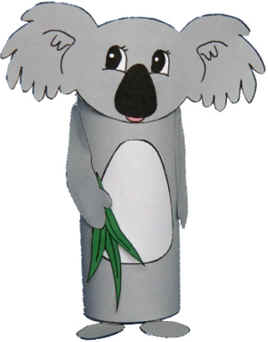 KOALAS
KOALAS
scientific name: Phascolarctos cinereus
Koalas are fascinating animals native to Australia. Often called "koala bears," these marsupials are not actually bears, but rather more closely related to kangaroos and wombats.
 Physical Characteristics:
Physical Characteristics:
Koalas are small animals, typically weighing between 9 to 33 pounds, with a body length of about 24 to 33 inches. They have round, fuzzy ears, a spoon-shaped nose, and a stocky body covered in thick, gray fur. Koalas have sharp claws and strong limbs, which enable them to climb trees effortlessly.
 Habitat:
Habitat:
Koalas are native to Australia and are primarily found in the eucalyptus forests along the eastern and southeastern coast. These marsupials are well-adapted to live in trees, where they spend most of their time. Koalas have a small home range, usually spanning a few acres, where they reside in a particular group of eucalyptus trees.
 Behavior:
Behavior:
Koalas are mostly nocturnal and spend most of their day sleeping, resting for up to 18-20 hours. They are solitary animals, interacting with other koalas primarily during the breeding season. Koalas communicate using a variety of sounds, such as grunts, snores, and bellows. They are shockingly noisy for such cute, little animals.
 Diet:
Diet:
Koalas have a specialized diet, consisting almost exclusively of eucalyptus leaves. Eucalyptus is toxic to most animals, but koalas have a unique digestive system that can break down the toxins. They consume up to 2.5 pounds of leaves per day, which also provide them with much of their water intake. Koalas have a low metabolic rate, allowing them to conserve energy and survive on their nutrient-poor diet.
 Reproduction:
Reproduction:
Koalas have a slow reproductive rate, with females typically breeding once every two years. Mating usually occurs between October and May. The gestation period is short, only about 33-35 days, after which a single, underdeveloped joey is born. The joey crawls into its mother's pouch, where it will continue to develop for about six months before emerging. It will then cling to its mother's back for another six months before becoming independent.
Challenges and Conservation:
Koalas face several threats, including habitat loss due to deforestation, urbanization, and climate change, which can cause heat stress and drought. Additionally, they are vulnerable to diseases, such as chlamydia, which can lead to infertility and even blindness.
Conservation efforts are in place to protect koalas and their habitat. These include reforestation initiatives, wildlife corridors, and monitoring populations to ensure their survival. Education and awareness campaigns also play a crucial role in koala conservation, as understanding these unique animals is essential for their long-term protection.
Five Fun and Unusual Facts About Koalas:
 Unique fingerprints:
Unique fingerprints:
Koalas have fingerprints that are strikingly similar to human fingerprints. In fact, they are so similar that even under a microscope, it can be challenging to differentiate between the two.- Low-energy lifestyle:
Koalas have one of the lowest metabolic rates among mammals. They sleep and rest for up to 18-20 hours a day to conserve energy, which allows them to survive on their nutrient-poor eucalyptus diet. - Selective eaters:
Despite having around 700 species of eucalyptus trees in Australia, koalas are very selective eaters, and only feed on approximately 30-40 species. They even have individual tree preferences within their home range. - Water-efficient animals:
Koalas get most of the water they need from the eucalyptus leaves they consume. The word "koala" comes from an Aboriginal word meaning "no drink," as they rarely need to drink water from other sources. - Vocal creatures:
Koalas are more vocal than one might expect. They use a variety of sounds to communicate, such as grunts, snores, and even loud, low-pitched bellows. These bellows, which can be heard from a considerable distance, are produced by a specialized vocal organ called the "velar vocal folds" – a feature unique to koalas.
 Conclusion:
Conclusion:
Koalas are captivating marsupials with specialized adaptations that enable them to thrive in their unique environment. It is vital to continue conservation efforts and raise awareness to protect these iconic Australian animals and their habitat for future generations to appreciate and enjoy.
 Koala Activities:
Koala Activities:
- Coloring pages
- Koala Paper Craft
- Koala Paper Plate Craft
- Koala Toilet Paper Roll Craft
- Koala Wreath
- On-line Koala Jigsaw Puzzles
